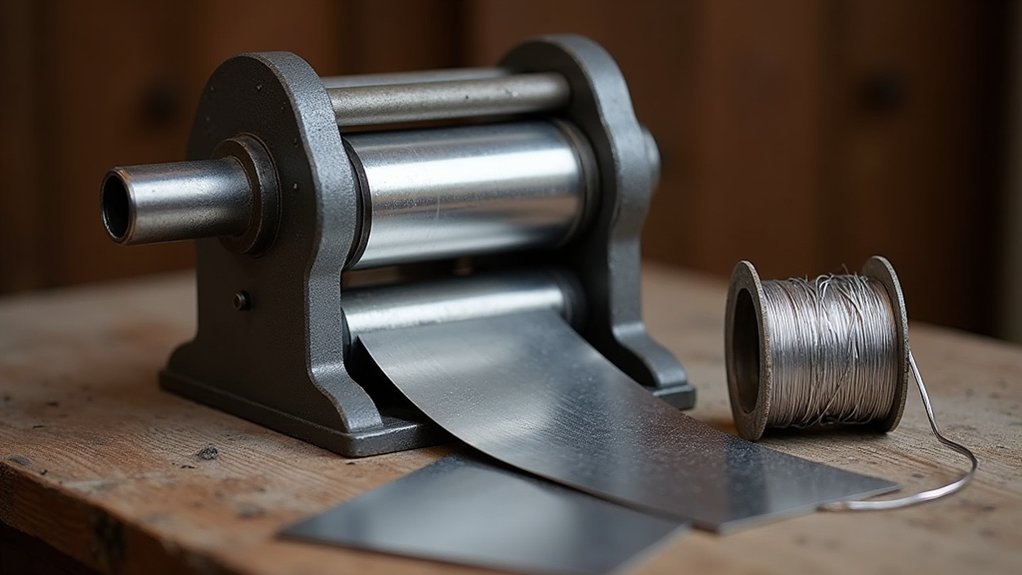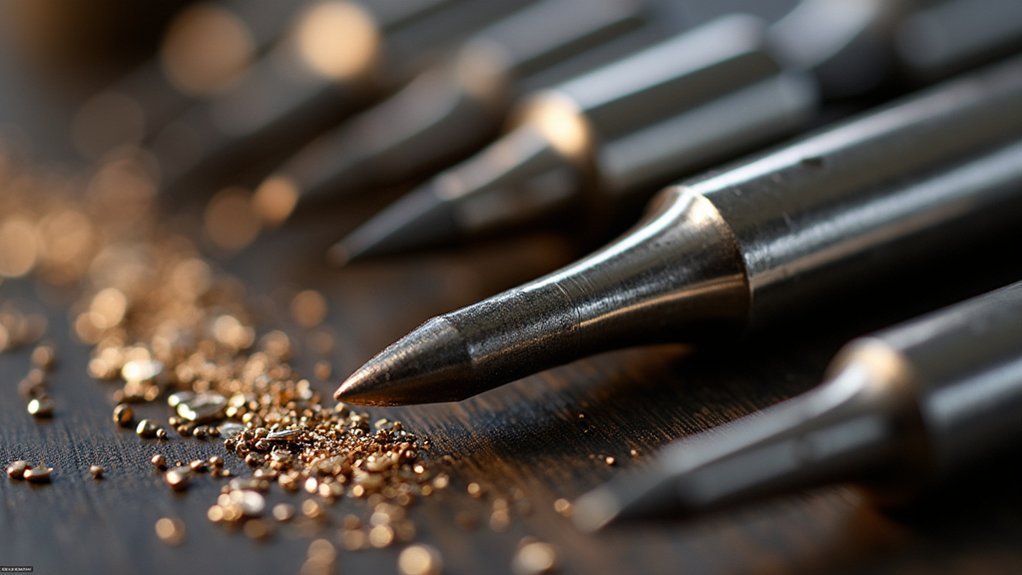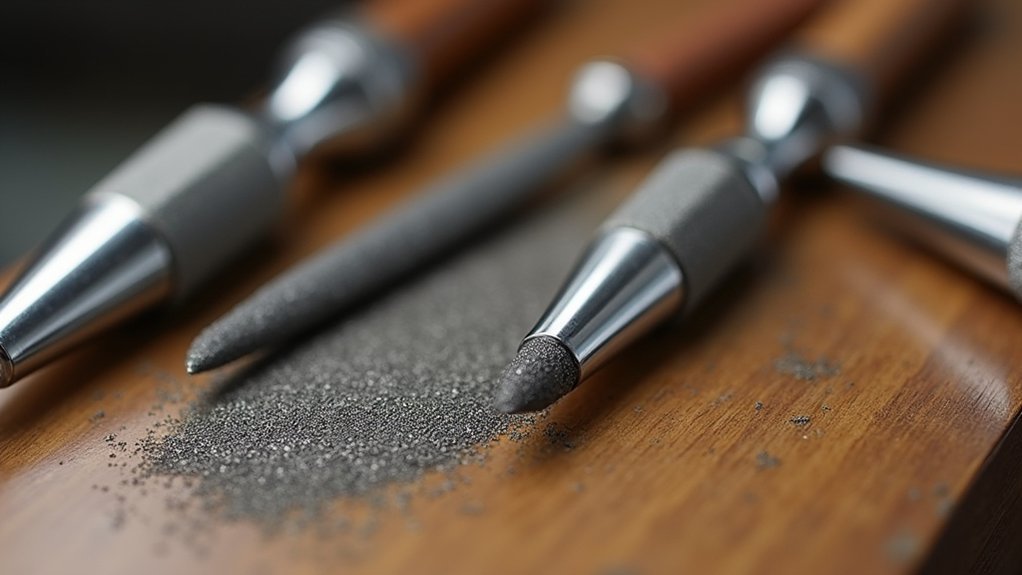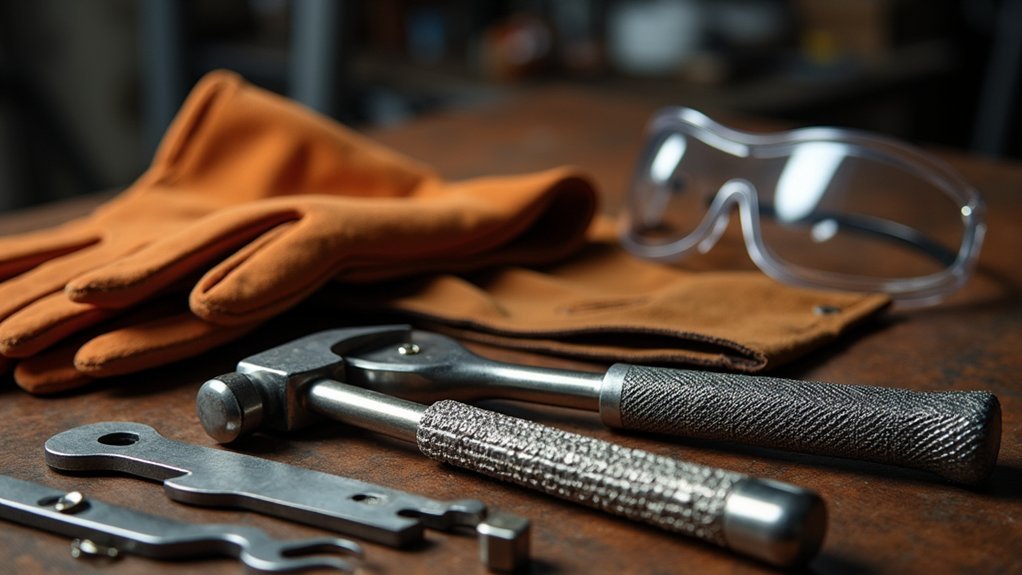You’ll need rolling mills to create uniform metal sheets and wire, along with various hammers and mallets for basic shaping tasks. Essential tools include mandrels and triblets for forming perfect circles, dapping blocks with punches for three-dimensional curves, and specialized pliers for precise wire manipulation. Don’t forget measurement tools like calipers for accuracy, plus safety equipment including goggles and gloves. These fundamental tools will transform your metalworking capabilities and open up endless creative possibilities.
Rolling Mills: Transforming Metal Sheets and Wire

When you’re working with metal sheets and wire in jewelry making, rolling mills become indispensable tools that transform these materials into thinner, more uniform shapes.
You’ll find that a rolling mill allows consistent metal shaping, which is critical for creating intricate designs and ensuring uniformity in your components.
The Durston Olivia C130 Rolling Mill stands out as a popular choice among jewelers.
You’ll appreciate its precision, reliability, and adjustable roller pressure that accommodates various metal thicknesses.
This durable construction enables you to work effectively with different metals, from soft gold to harder alloys.
Investing in a quality rolling mill greatly improves your metal shaping efficiency, making it an essential addition to your jewelry-making toolkit.
Hammers and Mallets: Basic Shaping Tools Every Jeweler Needs
After achieving uniform metal sheets and wire through rolling mills, you’ll need tools that shape these materials into specific forms and textures. Hammers and mallets become your primary shaping companions, each offering distinct advantages for different jewelry-making tasks.
Hammers and mallets transform uniform metal sheets into dimensional jewelry pieces, each tool offering distinct advantages for specific shaping tasks.
Ball peen hammers create rounded textures, while texturing hammers add unique surface patterns. Weight matters considerably—lighter hammers provide precise control for delicate work, whereas heavier ones handle substantial pieces effectively.
You’ll find rawhide mallets particularly valuable since they shape soft metals without leaving unwanted marks. Different hammer types produce varying effects on metal surfaces. Experimenting with multiple options helps you discover which tools complement your specific style and project requirements.
These essential hammers and mallets transform flat metal into dimensional jewelry pieces through controlled, purposeful strikes.
Mandrels and Triblets: Creating Perfect Circles and Curves

You’ll rely on mandrels and triblets to create the perfectly circular shapes that define professional ring making.
These steel tools come in different types, each designed for specific forming techniques that’ll transform flat metal into precise curves.
When you understand which mandrel to use and master the proper formation methods, you’ll achieve consistent, professional results every time.
Ring Formation Techniques
Two fundamental tools form the backbone of professional ring making: mandrels and triblets, both engineered to transform flat metal stock into perfectly circular jewelry pieces.
Your ring mandrel serves as the primary shaping tool, requiring steel construction for durability and a spotless surface to prevent unwanted marks on your metal. You’ll need to secure it firmly in a vice since it lacks size markings for reference.
When working with triblets, you’re focusing specifically on ring formation and reshaping. Pair your triblet with a rawhide mallet to shape metal without leaving hammer marks that compromise your piece’s integrity.
Clean tools are essential—any debris transfers directly to your jewelry. Accurate measurements and proper technique determine whether you’ll achieve professional-quality results or face costly remakes.
Mandrel Types Explained
Professional ring mandrels come in several distinct types, each engineered for specific applications in your workshop. Steel ring mandrels represent the most popular choice, offering exceptional durability and precision for consistent shaping without surface marks. You’ll find these mandrels available in various sizes to accommodate different ring dimensions.
| Mandrel Type | Primary Application | Key Advantage |
|---|---|---|
| Steel Ring Mandrels | General ring shaping | Durability and precision |
| Triblets | Specialized ring forming | Flat surface accuracy |
| Graduated Mandrels | Multiple ring sizes | Size versatility |
Triblets function similarly to standard mandrels but feature specialized flat surfaces for accurate ring formation. You should secure all mandrels in a sturdy vice during use to maintain ideal control and achieve professional results in your metalworking projects.
Dapping Blocks and Punches: Forming Three-Dimensional Shapes
When you’re ready to move beyond flat jewelry designs, dapping blocks and punches become your essential tools for creating three-dimensional curved forms like domed earrings and decorative bowl shapes.
You’ll need to think about whether wood or metal blocks suit your projects best, as wood blocks offer gentler forming that won’t mar delicate metals.
Your punch set selection directly impacts the variety of curves you can achieve, with economy 10-piece sets providing multiple sizing options for versatile shaping work.
Dapping Block Materials
The foundation of successful dapping work relies heavily on choosing the right block material for your specific jewelry-making needs.
You’ll find dapping blocks crafted from two primary materials: wood and metal, each offering distinct advantages for shaping metal sheets into three-dimensional forms.
Wood blocks provide excellent shock absorption and gentler forming action, making them ideal for delicate metals like silver or gold.
They’re also quieter during use and less likely to mar your metal surfaces.
Metal dapping blocks, typically made from steel or brass, offer superior durability and precision.
They’re perfect for harder metals and provide crisp, defined shapes.
However, you’ll need to maintain them carefully, removing any debris or oxidation that could compromise your finished pieces’ quality.
Punch Set Selection
Selecting the right dapping punches transforms your metal-shaping capabilities from basic to professional-grade results. Your punch set selection determines the variety of shapes you’ll achieve in your jewelry work. Consider piece size, project scope, and budget when choosing between different configurations.
| Set Type | Price | Best For |
|---|---|---|
| Economy 10 Piece | $39.16 | Multiple sizes, versatile projects |
| 5 Piece Wood Set | $9.20 | Uniform shapes, budget-friendly |
| Jumbo Wood (2 pieces) | $18.36 | Large metal pieces, deep forming |
You’ll find wood punches gentler on delicate metals, while extensive sets offer more creative possibilities. The 10-piece economy option provides excellent value for serious jewelry makers, whereas smaller sets work perfectly for beginners or specific techniques.
Creating Curved Forms
Beyond choosing your punches, you’ll discover that dapping blocks provide the foundation for transforming flat metal into curved, three-dimensional forms.
These metal forming tools work together as a system – the block creates a stable surface while punches apply controlled pressure to shape your metal sheets.
Wood dapping blocks offer gentle shaping capabilities without marring your metal’s surface, making them ideal for delicate work.
You’ll find that pairing a 5-piece wood dapping punch set with these blocks gives you precise control over specific shapes and sizes.
For larger projects requiring substantial curves, jumbo wood forming punches provide the power you need.
The economy 10-piece sets typically include various punch sizes, ensuring you can accommodate different curves and achieve professional three-dimensional results in your jewelry pieces.
Pliers and Forming Tools: Precision Wire and Sheet Manipulation
When crafting jewelry, you’ll find that pliers and forming tools serve as extensions of your hands, enabling precise manipulation of wire and sheet metal that would be impossible through manual force alone.
Round-nose pliers excel at creating clean loops and graceful curves, while flat-nose pliers provide the gripping strength needed for bending wire into sharp angles. Your forming tools, including mandrels and triblets, shape metal into perfect rings and circular forms with mathematical precision.
You’ll want to pair these with a rawhide mallet to prevent surface damage during shaping.
Before manipulating any metal, use calipers and metal rulers for accurate measurements. Quality pliers with comfortable grips reduce hand fatigue and improve your control when handling delicate components.
Anvils and Steel Blocks: Foundation Tools for Heavy Forming

While precision tools handle delicate work, anvils and steel blocks form the backbone of heavy-duty jewelry making operations.
You’ll find these foundation tools essential when shaping metal requires substantial force and stability. Anvils feature flat surfaces and tapered ends that let you alter metal contours through controlled hammering, while steel blocks provide the hard, stable surface needed for texturing and punching operations.
Essential considerations for anvils and steel blocks:
- Weight matters – Heavier tools provide better stability during forceful forming work
- Surface maintenance – Keep surfaces clean and polished to prevent transferring marks
- Bench anvils – Compact versions perfect for jewelry’s intricate scale requirements
- Versatile applications – Support everything from basic flattening to complex contouring
- Complementary function – Work alongside hammers and mallets for ideal results
Bending Bars and Forming Stakes: Specialized Shaping Solutions
When you’re ready to move beyond basic forming, bending bars and forming stakes become your go-to tools for creating precise curves and complex shapes in metal.
You’ll find that bending bars excel at creating consistent angles and smooth curves in wire and sheet metal, while forming stakes provide the specialized surfaces needed for shaping three-dimensional forms.
These professional-grade tools transform your ability to execute sophisticated shaping techniques that would be nearly impossible with standard equipment alone.
Bending Bar Applications
Three primary applications make bending bars indispensable in your jewelry workshop: creating uniform curves in wire, forming consistent angles in sheet metal, and establishing precise radii for ring shanks.
When you’re working with wire jewelry, bending bars help you achieve professional-grade curves that maintain consistency across multiple pieces. The flat surfaces and varied radii guarantee you can replicate exact measurements every time.
For sheet metal projects, these tools enable precise angle formation essential for:
- Creating consistent bezels for stone settings
- Forming uniform jump rings and findings
- Establishing clean corners in rectangular designs
- Maintaining symmetrical curves in pendant shapes
- Achieving professional-grade edge work
Ring making particularly benefits from bending bars, as they allow you to establish the exact curvature needed for proper sizing while maintaining structural integrity throughout the forming process.
Forming Stakes Benefits
Forming stakes complement bending bars by offering you specialized surfaces that transform flat metal into three-dimensional jewelry components.
You’ll find these tools feature various shapes and profiles that enable unique textures and contours in your metalwork. When you use forming stakes, you’re getting sturdy surfaces that guarantee your desired form develops without distortion, maintaining the integrity of your design.
The controlled manipulation you achieve with forming stakes reduces material damage risk while delivering professional-level results. You can execute complex shapes that would be impossible with basic tools alone.
These specialized surfaces work particularly well when you need precise curves and intricate details. Forming stakes fundamentally bridge the gap between basic shaping and advanced jewelry construction techniques.
Professional Shaping Techniques
Because professional metalworking demands precision beyond what basic tools can deliver, you’ll need to master specialized techniques that combine bending bars and forming stakes for superior results.
These essential tools work together to create complex curves and angles that define high-quality jewelry pieces.
Professional shaping techniques require understanding how to leverage both tools effectively:
- Position metal securely against forming stakes before applying pressure
- Use bending bars with controlled, gradual movements to prevent stress fractures
- Select appropriate stake shapes that match your desired contour specifications
- Apply consistent force distribution to maintain uniform thickness throughout bends
- Combine multiple shaping passes for complex geometric formations
You’ll achieve superior craftsmanship by mastering these coordinated techniques, ensuring your finished pieces display the precision and detail that distinguish professional jewelry work.
Press Tools and Hydraulic Equipment: Power-Assisted Metal Forming
Several revolutionary tools have transformed modern jewelry making, but none match the precision and power of hydraulic presses and press tools for metal forming.
You’ll find these press tools essential for applying consistent, powerful force to shape metal into desired forms. Hydraulic equipment gives you precise control over pressure, enabling intricate designs and detailed patterns.
You’ll appreciate how these tools reduce physical effort while enhancing productivity and efficiency in your workshop. You can use them for stamping, bending, and forming metal sheets and wires, making them versatile additions.
Investing in high-quality hydraulic equipment leads to improved precision and repeatability, resulting in higher craftsmanship standards in your finished jewelry pieces.
Burnishers and Smoothing Tools: Refining Formed Metal Surfaces

After you’ve successfully shaped your metal using hydraulic presses and forming equipment, the real artistry begins with refining those surfaces to professional standards.
The true mastery of metalworking emerges when transforming shaped pieces into flawlessly refined, professional-grade surfaces.
Burnishers are essential tools that transform rough metal into polished perfection through burnishing. You’ll enhance shine and smoothness while eliminating imperfections that could compromise your piece’s value.
Smoothing tools create professional finishes that elevate your jewelry’s quality:
- Files and polishing compounds remove rough edges and surface flaws
- Progressive grit polishing papers refine surfaces from coarse to fine finishes
- Curved burnishers ($3.00) reach intricate areas and curved surfaces effectively
- Systematic burnishing improves both aesthetic appeal and durability
- Professional surface refinement greatly increases your jewelry’s overall value
These tools guarantee your formed metal achieves the polished excellence that distinguishes professional jewelry.
Measurement and Marking Tools: Ensuring Accurate Metal Shaping
Precision forms the foundation of professional jewelry making, and your measurement tools determine whether your metal shaping efforts result in amateur mistakes or masterpiece-quality pieces.
Calipers and metal rulers guarantee symmetrical designs and consistent sizing throughout your work. You’ll rely on dividers to mark precise dimensions and layouts before shaping metal, establishing critical reference points for accurate cuts and bends.
Center punches create exact indentations for drilling or cutting locations, preventing drill bits from wandering across metal surfaces.
Ring sizers eliminate guesswork when crafting rings, guaranteeing proper fit without requiring post-shaping adjustments.
Investing in quality measurement tools greatly elevates your finished jewelry’s precision and overall quality, transforming your metalworking from trial-and-error attempts into confident, professional-grade craftsmanship.
Safety Equipment for Metal Forming: Essential Protective Gear

While precision creates beautiful jewelry, protective gear keeps you safe during every metal forming process.
Safety equipment isn’t optional—it’s your first line of defense against workshop hazards that can cause serious injury.
Essential protective gear includes:
- Safety goggles – Shield your eyes from flying debris and metal particles during shaping processes
- Dust masks – Prevent inhalation of fine particles from filing and sanding, protecting respiratory health
- Work gloves – Guard hands against cuts and burns when handling sharp tools or hot metals
- Ear protection – Reduce hearing damage risk from high-noise power tools
- Closed-toe shoes – Protect feet from falling tools and heavy materials in workshop environments
Investing in proper safety equipment protects your health while you perfect your metalworking craft.
Frequently Asked Questions
What Tools Are Used to Shape Metal?
You’ll use hammers and mallets to strike metal, anvils for sturdy shaping surfaces, pliers for bending wire, mandrels for forming rings, and dapping sets for creating domed shapes in your metalworking projects.
What Tools Do I Need for Metal Jewelry Making?
You’ll need pliers for gripping and bending wire, a jeweler’s saw for cutting metal, dapping tools for creating domes, nylon hammers for shaping without damage, and calipers for precise measurements.
What Tool Is Used to Shape Rings?
You’ll use a ring mandrel as your primary tool for shaping rings. It’s a tapered steel rod that provides a sturdy surface to form metal into perfect circular shapes while maintaining precise sizing.
What Equipment Does a Jeweler Use?
You’ll use mandrels and clamps for shaping, rolling mills like the Durston Olivia for precision forming, micro welders for joining parts, jeweler’s saws for cutting, and files for finishing your pieces.
In Summary
You’ll find that mastering these metal-shaping tools takes practice, but they’re essential for creating professional jewelry. Start with basic hammers, mandrels, and pliers, then gradually add specialized equipment like rolling mills and dapping blocks as your skills develop. Don’t forget proper safety gear – you can’t create beautiful pieces if you’re injured. With consistent practice and the right tools, you’ll transform raw metal into stunning jewelry pieces that’ll last generations.





Leave a Reply